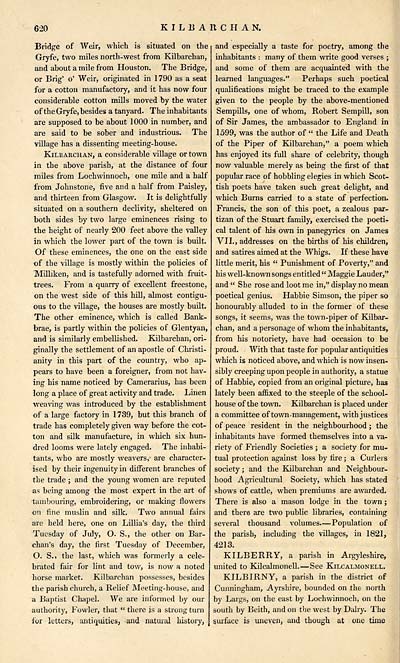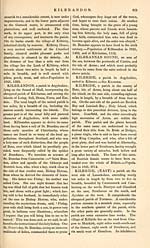Gazetteer of Scotland > Volume 2
(136) Page 620 - KIL
Download files
Complete book:
Individual page:
Thumbnail gallery: Grid view | List view

620
KILBARCHAN.
Bridge of Weir, which is situated on the
Gryfe, two miles north-west from Kilbarchan,
and about a mile from Houston. The Bridge,
or Brig' o' Weir, originated in 1790 as a seat
for a cotton manufactory, and it has now four
considerable cotton mills moved by the water
of the Gryfe, besides a tany ard. The inhabitants
are supposed to be about 1000 in number, and
are said to be sober and industrious. The
village has a dissenting meeting-house.
Kilbarchan, a considerable village or town
in the above parish, at the distance of four
miles from Lochwinnoch, one mile and a half
from Johnstone, five and a half from Paisley,
and thirteen from Glasgow. It is delightfully
situated on a southern declivity, sheltered on
both sides by two large eminences rising to
the height of nearly 200 feet above the valley
in which the lower part of the town is built.
Of these eminences, the one on the east side
of the village is mostly within the policies of
Milliken, and is tastefully adorned with fruit-
trees. From a quarry of excellent freestone,
on the west side of this hill, almost contigu-
ous to the village, the houses are mostly built.
The other eminence, which is called Bank-
brae, is partly within the policies of Glentyan,
and is similarly embellished. Kilbarchan, ori-
ginally the settlement of an apostle of Christi-
anity in this part of the country, who ap-
pears to have been a foreigner, from not hav-
ing his name noticed by Camerarius, has been
long a place of great activity and trade. Linen
weaving was introduced by the establishment
of a large factory in 1739, but this branch of
trade has completely given way before the cot-
ton and silk manufacture, in which six hun-
dred looms were lately engaged. The inhabi-
tants, who are mostly weavers, are character-
ised by their ingenuity in different branches of
the trade ; and the young women are reputed
as being among the most expert in the art of
tambouring, embroidering, or making flowers
on fine muslin and silk. Two annual fairs
are held here, one on Lillia's day, the third
Tuesday of July, O. S., the other on Bar-
chan's day, the first Tuesday of December,
O. S., the last, which was formerly a cele-
brated fair for lint and tow, is now a noted
horse market. Kilbarchan possesses, besides
the parish church, a Relief Meeting-house, and
a Baptist Chapel. We are informed by our
authority, Fowler, that " there is a strong turn
for letters, antiquities, and natural history,
and especially a taste for poetry, among the
inhabitants : many of them write good verses ;
and some of them are acquainted with the
learned languages." Perhaps such poetical
qualifications might be traced to the example
given to the people by the above-mentioned
Sempills, one of whom, Robert Sempill, son
of Sir James, the ambassador to England in
1599, was the author of " the Life and Death
of the Piper of Kilbarchan," a poem which
has enjoyed its full share of celebrity, though
now valuable merely as being the first of that
popular race of hobbling elegies in which Scot-
tish poets have taken such great delight, and
which Burns carried to a state of perfection.
Francis, the son of this poet, a zealous par-
tizan of the Stuart family, exercised the poeti-
cal talent of his own in panegyrics on James
VII., addresses on the births of his children,
and satires aimed at the Whigs. If these have
little merit, his " Punishment of Poverty," and
his well-known songs entitled " Maggie Lauder,"
and " She rose and loot me in," display no mean
poetical genius. Habbie Simson, the piper so
honourably alluded to in the former of these
songs, it seems, was the town-piper of Kilbar-
chan, and a personage of whom the inhabitants,
from his notoriety, have had occasion to be
proud. With that taste for popular antiquities
which is noticed above, and which is now insen-
sibly creeping upon people in authority, a statue
of Habbie, copied from an original picture, has
lately been affixed to the steeple of the school-
house of the town. Kilbarchan is placed under
a committee of town-management, with justices
of peace resident in the neighbourhood ; the
inhabitants have formed themselves into a va-
riety of Friendly Societies ; a society for mu-
tual protection against loss by fire ; a Curlers
society; and the Kilbarchan and Neighbour-
hood Agricultural Society, which has stated
shows of cattle, when premiums are awarded.
There is also a mason lodge in the town ;
and there are two public libraries, containing
several thousand volumes — Population of
the parish, including the villages, in 1821,
4213.
KILBERRY, a parish in Argyleshire,
united to Kilcalmonell. — See Kilcalmonell.
KILBIRNY, a parish in the district of
Cunningham, Ayrshire, bounded on the north
by Largs, on the east by Lochwinnoch, on the
south by Beith, and on the west by D;dry. The
surface is uneven, and though at one time
KILBARCHAN.
Bridge of Weir, which is situated on the
Gryfe, two miles north-west from Kilbarchan,
and about a mile from Houston. The Bridge,
or Brig' o' Weir, originated in 1790 as a seat
for a cotton manufactory, and it has now four
considerable cotton mills moved by the water
of the Gryfe, besides a tany ard. The inhabitants
are supposed to be about 1000 in number, and
are said to be sober and industrious. The
village has a dissenting meeting-house.
Kilbarchan, a considerable village or town
in the above parish, at the distance of four
miles from Lochwinnoch, one mile and a half
from Johnstone, five and a half from Paisley,
and thirteen from Glasgow. It is delightfully
situated on a southern declivity, sheltered on
both sides by two large eminences rising to
the height of nearly 200 feet above the valley
in which the lower part of the town is built.
Of these eminences, the one on the east side
of the village is mostly within the policies of
Milliken, and is tastefully adorned with fruit-
trees. From a quarry of excellent freestone,
on the west side of this hill, almost contigu-
ous to the village, the houses are mostly built.
The other eminence, which is called Bank-
brae, is partly within the policies of Glentyan,
and is similarly embellished. Kilbarchan, ori-
ginally the settlement of an apostle of Christi-
anity in this part of the country, who ap-
pears to have been a foreigner, from not hav-
ing his name noticed by Camerarius, has been
long a place of great activity and trade. Linen
weaving was introduced by the establishment
of a large factory in 1739, but this branch of
trade has completely given way before the cot-
ton and silk manufacture, in which six hun-
dred looms were lately engaged. The inhabi-
tants, who are mostly weavers, are character-
ised by their ingenuity in different branches of
the trade ; and the young women are reputed
as being among the most expert in the art of
tambouring, embroidering, or making flowers
on fine muslin and silk. Two annual fairs
are held here, one on Lillia's day, the third
Tuesday of July, O. S., the other on Bar-
chan's day, the first Tuesday of December,
O. S., the last, which was formerly a cele-
brated fair for lint and tow, is now a noted
horse market. Kilbarchan possesses, besides
the parish church, a Relief Meeting-house, and
a Baptist Chapel. We are informed by our
authority, Fowler, that " there is a strong turn
for letters, antiquities, and natural history,
and especially a taste for poetry, among the
inhabitants : many of them write good verses ;
and some of them are acquainted with the
learned languages." Perhaps such poetical
qualifications might be traced to the example
given to the people by the above-mentioned
Sempills, one of whom, Robert Sempill, son
of Sir James, the ambassador to England in
1599, was the author of " the Life and Death
of the Piper of Kilbarchan," a poem which
has enjoyed its full share of celebrity, though
now valuable merely as being the first of that
popular race of hobbling elegies in which Scot-
tish poets have taken such great delight, and
which Burns carried to a state of perfection.
Francis, the son of this poet, a zealous par-
tizan of the Stuart family, exercised the poeti-
cal talent of his own in panegyrics on James
VII., addresses on the births of his children,
and satires aimed at the Whigs. If these have
little merit, his " Punishment of Poverty," and
his well-known songs entitled " Maggie Lauder,"
and " She rose and loot me in," display no mean
poetical genius. Habbie Simson, the piper so
honourably alluded to in the former of these
songs, it seems, was the town-piper of Kilbar-
chan, and a personage of whom the inhabitants,
from his notoriety, have had occasion to be
proud. With that taste for popular antiquities
which is noticed above, and which is now insen-
sibly creeping upon people in authority, a statue
of Habbie, copied from an original picture, has
lately been affixed to the steeple of the school-
house of the town. Kilbarchan is placed under
a committee of town-management, with justices
of peace resident in the neighbourhood ; the
inhabitants have formed themselves into a va-
riety of Friendly Societies ; a society for mu-
tual protection against loss by fire ; a Curlers
society; and the Kilbarchan and Neighbour-
hood Agricultural Society, which has stated
shows of cattle, when premiums are awarded.
There is also a mason lodge in the town ;
and there are two public libraries, containing
several thousand volumes — Population of
the parish, including the villages, in 1821,
4213.
KILBERRY, a parish in Argyleshire,
united to Kilcalmonell. — See Kilcalmonell.
KILBIRNY, a parish in the district of
Cunningham, Ayrshire, bounded on the north
by Largs, on the east by Lochwinnoch, on the
south by Beith, and on the west by D;dry. The
surface is uneven, and though at one time
Set display mode to: Large image | Transcription
Images and transcriptions on this page, including medium image downloads, may be used under the Creative Commons Attribution 4.0 International Licence unless otherwise stated. ![]()
| Gazetteers of Scotland, 1803-1901 > Gazetteer of Scotland > Volume 2 > (136) Page 620 - KIL |
|---|
| Permanent URL | https://digital.nls.uk/97432454 |
|---|
| Description | Volume II: Glenbanchor to Zetland. |
|---|---|
| Attribution and copyright: |
|
| Description | By Robert Chambers and William Chambers. Glasgow: Blackie & Son, 1838. 2 volumes. |
|---|---|
| Shelfmark | NF.1461.g.7 |
| Additional NLS resources: | |

